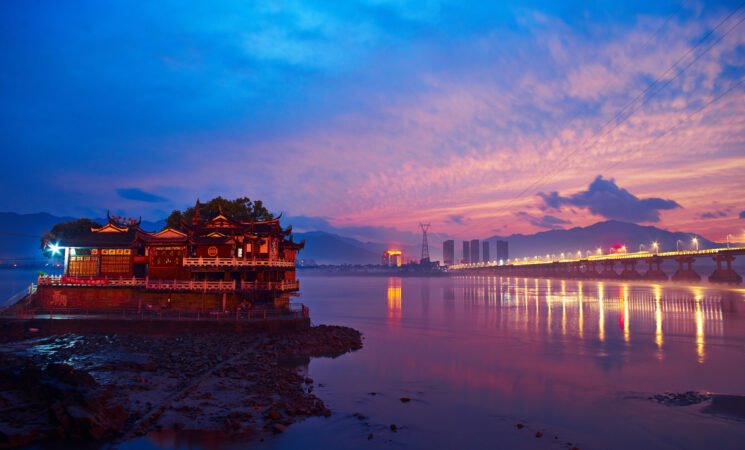21 June 2025, NIICE Commentary 11330
Bornika Borah
One of the most ambitious infrastructure projects ever imagined is China's Belt and Road Initiative (BRI), also known as the New Silk Road. The extensive investment and development program was first conceived in 2013 by President Xi Jinping to physically connect East Asia and Europe. The project has spread to Africa, Oceania, and Latin America in the ten years since, significantly increasing China's political and economic clout. While China promotes the Maritime Silk Road as a path to shared prosperity, infrastructure connectivity, and win-win cooperation, the reality is more complex. Deliberate efforts to secure sea lanes, increase naval reach, and acquire influence in the Indo-Pacific region are the driving forces behind port investments and trade corridors.
At the heart of the MSR are port developments that serve dual purposes — they facilitate trade while enabling potential military applications. These so-called dual-use ports have become focal points of geopolitical debate. For instance, ports in Gwadar (Pakistan) and Hambantota (Sri Lanka) were built with Chinese loans and contractors. While officially for commercial shipping, these facilities feature deep-water berths, fuel storage, and other logistics that can support Chinese Navy vessels (PLAN). In Djibouti, China has already established a full-fledged naval base — its first overseas. These developments allow Beijing to establish a logistical and strategic footprint far beyond its shores, raising concerns about the future of regional autonomy and freedom of navigation.
A "String of Pearls"—a collection of ports connected to the MSR that encircle India—is a common description of China's expanding influence in the Indian Ocean. India has responded by developing maritime alliances and enhancing naval capabilities as part of its "Necklace of Diamonds" strategy. Efforts include commissioning new platforms like the INS Vikrant (its first indigenous aircraft carrier), enhancing submarine capabilities, and securing logistics agreements with countries like Oman, Seychelles, and Singapore. India also plays a central role in the Quad, alongside the U.S., Japan, and Australia — a grouping increasingly focused on Indo-Pacific security and freedom of navigation. Meanwhile, Pakistan's close alignment with China through Gwadar has increased India's strategic concerns.
China's ambitions do not stop in the Indian Ocean as in 2022, it entered into a security pact with the Solomon Islands, allowing Chinese police and potentially military troops to use the islands. The deal alarmed regional powers like Australia and the U.S., who feared it could enable a permanent Chinese military presence in the South Pacific. With growing Chinese aid and infrastructure projects in Vanuatu, Papua New Guinea, and Kiribati, Beijing's influence in the Pacific is becoming a central theme in regional diplomacy and defence planning.
The Indo-Pacific's geography is marked by chokepoints like the Strait of Malacca, through which about 80% of China's oil imports pass. To address this vulnerability — dubbed the "Malacca Dilemma" — China invests in alternative routes such as the China-Myanmar Economic Corridor (CMEC) and inland connections from Gwadar. These alternative routes further connect national defence priorities with economic infrastructure by reducing reliance on U.S.-controlled sea lanes and ensuring energy security. China's BRI financing model often relies on loans from developing countries that cannot repay them. The most famous example is Sri Lanka's Hambantota Port, which was leased to a Chinese state-owned enterprise for 99 years after Colombo defaulted on its debt. Other countries, including Djibouti and the Maldives, have accumulated substantial debts to Chinese lenders. While some analysts argue that the "debt-trap diplomacy" narrative is overblown, others warn that economic vulnerability can lead to strategic concessions, especially in the maritime domain.
As China's maritime reach expands, so does regional military activity. The U.S. Navy has intensified freedom of navigation operations (FONOPs) in contested waters, while exercises like Malabar and RIMPAC foster interoperability among regional allies. The creation of AUKUS — a trilateral security pact between Australia, the UK, and the U.S. — marks a more profound realignment, enabling Australia to acquire nuclear-powered submarines. Countries like Vietnam and Indonesia are also upgrading their naval assets. As maritime zones become increasingly contested, legal frameworks like the United Nations Convention on the Law of the Sea (UNCLOS) are under pressure. While China is a signatory, it rejected the 2016 arbitration ruling, invalidating its claims regarding the South China Sea.
As this is happening, ASEAN finds it challenging to project unity, with some member states siding more closely with Beijing and others remaining cautious. The absence of a code of conduct and procedures for fostering confidence increases the likelihood of maritime conflict, particularly as coast guard and naval activity increases.
In addition to trade, the Maritime Silk Road is changing the Indo-Pacific's strategic geography through port ownership, debt exposure, and military access. Future situations include a bipolar maritime order centred on China and the United States, escalating bloc politics between opposing and MSR-aligned powers—a move toward new regional frameworks for supply chain resilience, port access, and maritime security. The future of marine governance and regional stability will be determined by how well cooperation and competition are balanced, even though conflict is not inevitable.
Bornika Borah is a Research Intern at NIICE and is currently pursuing her Master's in International Studies at Christ University, Bengaluru, India.

